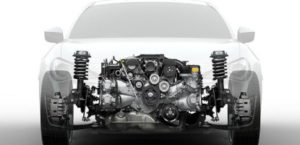The 2.0-liter Volkswagen DKZA turbo engine has been produced by the German concern since 2018 and is installed on such popular models as Arteon, Passat, T-Roc, Skoda Octavia and Superb. The unit is distinguished by combined fuel injection and Miller’s economical cycle operation.
The EA888 gen3b series includes: CZPA, CZPB, DKZA, CVKB, CYRB, CYRC.
Specifications
| Production years | since 2018 |
| Displacement, cc | 1984 |
| Fuel system | FSI + MPI |
| Power output, hp | 190 |
| Torque output, Nm | 320 |
| Cylinder block | cast iron R4 |
| Block head | aluminum 16v |
| Cylinder bore, mm | 82.5 |
| Piston stroke, mm | 92.8 |
| Compression ratio | 11.6 |
| Features | Miller Cycle |
| Hydraulic lifters | yes |
| Timing drive | chain |
| Phase regulator | on both shafts |
| Turbocharging | IHI IS20 |
| Recommended engine oil | 0W-30 |
| Engine oil capacity, liter | 5.7 |
| Fuel type | petrol |
| Euro standards | EURO 6 |
| Fuel consumption, L/100 km (for Skoda Octavia 2021) — city — highway — combined |
10.6 6.4 8.0 |
| Engine lifespan, km | ~250 000 |
| Weight, kg | 132 |
The engine was installed on:
- Audi A3 3 (8V) in 2019 – 2020;
- Audi Q2 1 (GA) in 2018 – 2020;
- Seat Ateca 1 (KH) since 2018;
- Seat Leon 3 (5F) in 2018 – 2019; Leon 4 (KL) since 2020;
- Seat Tarraco 1 (KN) since 2019;
- Skoda Karoq 1 (NU) since 2019;
- Skoda Kodiaq 1 (NS) since 2019;
- Skoda Octavia 4 (NX) since 2020;
- Skoda Superb 3 (3V) since 2019;
- Volkswagen Arteon 1 (3H) since 2019;
- Volkswagen Passat B8 (3G) since 2019;
- Volkswagen Tiguan 2 (AD) since 2019;
- Volkswagen T-Roc 1 (A1) since 2018.
Disadvantages of the VW DKZA engine
- The weak point of the motor is the short-lived plastic case of the water pump;
- Quite often there are oil leaks along the front of the valve cover;
- With a very dynamic ride, the crankcase ventilation system cannot cope and oil enters the intake;
- On specialized forums, they often complain about problems with the GPF particulate filter.






